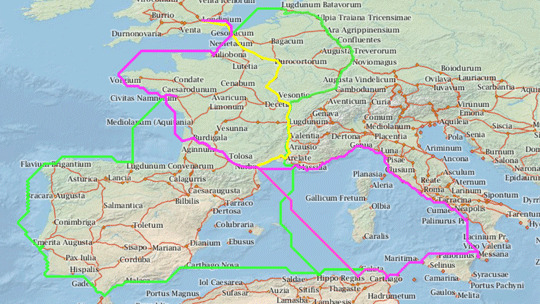Anthropology
Related: About this forumWhat did it cost to travel to London or Athens from Ancient Rome?
Now you can find out.

In the month of July, generally a favorable time of the year for travel, the fastest connection utilizing all four modes (road travel by pack animal, river travel by civilian boat, open sea and coastal sea travel on the faster sailing ship) is represented by the purple line that crosses the western Mediterranean in a northwesterly direction, cuts across southwestern Gaul (France) in part by using the river Garonne and subsequently follows the Atlantic coast to the final destination. Travel time is 27.2 days over a distance of 3,099km (or 114km/day), at a cost of 7.8 denarii per kilogram using a donkey for land transport.
Disabling the open sea function diverts the fastest route to track the coast of Sicily and Italy, a change that increases travel time by 40 percent to 37.4 days and distance by the same rate to 4,384km (or 117km/day), while the price rises by no more than one-eighth to 8.8 denarii thanks to the continuing predominance of cheap maritime travel. The low price cost of sailing also accounts for the fact that the cheapest route overall for the original four modes and settings (displayed in green) takes a very different path, relying as it does as much as possible on the sea and therefore completing virtually the entire voyage by sea ship, a choice that results in a comparable travel time of 37 days over a longer distance of 5,097km (or 138km/day) but halves the price to merely 3.7 denarii/kg.
This route depends on access to Atlantic shipping: an easy way of excluding this particular option is by selecting the same configuration of modes and settings for the month of January, when heavy winds curtailed sailing in the Atlantic Ocean. This creates a dramatically different path, represented by the green line that initially curves across the western Mediterranean in order to avoid the area of rough winter weather west of Sardinia and later relies as much as possible on river transport, first up the Rhone and then down the Rhine, before sailing to the mouth of the Thames.
In this scenario, travel time increases massively to 93.2 days over 3,361km (or 36km/day) while the price rises fourfold to 15.7 denarii/kg. The yellow route (for the original modes and settings, in July), partly obscured by (purple) the sea route from Carthago to Narbo (Narbonne), shows the physically shortest route, which at 2,403km is almost a quarter shorter than the fastest route but, at 36.2 denarii/kg, also far more expensive than any of the others because it does not shy away from expensive road travel.
http://orbis.stanford.edu/
On the coinage denarii
The denarius began to undergo slow debasement towards the end of the Republic. Under the rule of Augustus its silver content fell to 3.9 grams (a theoretical weight of 1?84 of a Roman pound). It then remained at near this weight until the time of Nero, when it was reduced to 1?96 of a pound, or 3.4 grams. Debasement of the silver continued after Nero. Later Roman emperors reduced it to a weight of 3 grams around the late 3rd century.
The value at its introduction was 10 asses, giving the denarius its name which translates to "containing ten". In about 141 BC it was re-tariffed at 16 asses, to reflect the decrease in weight of the as. The denarius continued to be the main coin of the Roman Empire until it was replaced by the antoninianus in the middle of the 3rd century. The last issuance for this coin seems to be bronze coins issued by Aurelian between AD 270 and 275, and in the first years of the reign of Diocletian.
http://en.wikipedia.org/wiki/Denarius
cally
(21,591 posts)The wikipedia article says that workers typically received one denarius per day so it would only take 4 days to pay for a trip. That's amazing!!!